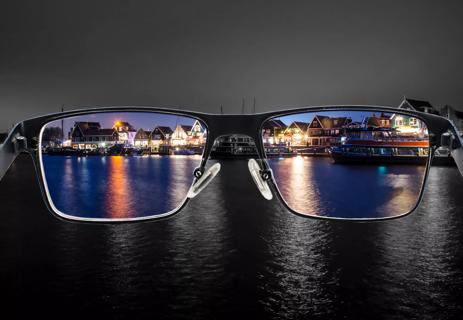Some eye conditions can have more noticeable effects at night

It’s a pretty common occurrence, particularly as we age. You’re driving down the street at night and suddenly you find yourself gripping the steering wheel a little harder. Squinting more than usual. Leaning forward in your seat to get a better view.
Advertisement
Cleveland Clinic is a non-profit academic medical center. Advertising on our site helps support our mission. We do not endorse non-Cleveland Clinic products or services. Policy
The streetlights are casting off a halo of light. And come to think of it, the headlights coming at you seem bigger and fuzzier than they used to.
Seeing halos — like bright circles or rings around a light source — can be disconcerting. And it can really affect your ability to drive safely at night.
“Some degree of halos in your vision is totally normal,” says ophthalmology specialist Nicole Bajic, MD. “But when halos are affecting how well you see, particularly if they’re creating a situation where it’s getting dangerous to drive, that’s something you should get checked out.”
Dr. Bajic explains why we get halos in our vision and what could be going on in our eyes.
To understand where halos in your vision come from, let’s start with some basics of how your eyes work.
Your cornea is the front layer of your eye. Dr. Bajic calls it “the windshield of the eye.”
Usually, the cornea slopes gently and rounds in the middle of your eye. It’s essentially the shape of a contact lens or a ball that’s been cut in half.
“For some people, that slope can be exaggerated, or a little bit off-kilter or more like a cone shape or other shapes,” Dr. Bajic says. “Many light aberrations (a failure of light rays to all converge at the same point) can be related to the shape and curvature of your cornea.”
Advertisement
In other words, the shape of your cornea and other structures in your eyes can change the way that light enters your eye, leaving you with a distorted view, like halos.
And it’s worth noting that it’s not just at night that your vision may be impacted. But some vision troubles may be more noticeable at night because a bright light on a dark background makes those halos really pop.
What would cause a misshapen cornea and, therefore, the look of halos on your evening ride? Dr. Bajic offers a few reasons.
People with myopia, also called nearsightedness, have trouble seeing objects at a distance. The American Optometric Association says myopia affects nearly 30% of the U.S. population. People with myopia tend to wear glasses or contacts to correct their vision.
Even if you have 20/20 vision, there’s a condition known as “night myopia,” which could cause some blurred vision only at night, when your pupils naturally open wider to see in the dark.
“As your eyes dilate more, you have more peripheral light rays entering. The light hits the further periphery of the lens inside the eye, which can cause a significant change in how things appear,” Dr. Bajic explains.
“Astigmatism” is the word for eyes that aren’t perfectly round — meaning your cornea or lens is more curved than it should be. That oblong shape can affect how light rays enter and transmit through your eye, causing halos and blurred vision.
Many people with astigmatism wear glasses or contacts, but some may not. Astigmatism may worsen over time, though. So, even if you haven’t needed corrective lenses in the past, you may come to need them as you age.
Dry eyes can be a real nuisance, and for some people, can cause blurriness and halo effects.
“For someone with significant dry eye, the surface of the eye is not well lubricated, which can affect how light rays are transmitted into the eyes,” Dr. Bajic says. “Not everyone with dry eyes will see halos, but any deviation from normal can certainly cause a halo effect.”
It’s very common as we age that our eyes may need some help in seeing far away, close up and even a few different points in the middle. But rather than having several different pairs of glasses around for each of those distances, many people rely on multifocal glasses or contact lenses.
These lenses are made by merging several different prescriptions into one clear lens. Looking through the top of the lens allows you to see longer distance, the middle allows you to see mid-range and the bottom of the lens helps bring objects up close into focus.
But those various “bands” of prescription can cause light to split as they transition from one prescription strength to the next, Dr. Bajic notes. And that can cause a halo effect.
Advertisement
Laser eye surgery procedures, like Photorefractive Keratectomy (PRK)® or LASIK® are used to correct nearsightedness, farsightedness and astigmatism. These procedures use lasers to reshape your cornea so it reflects light properly onto your retina. It allows people to see normally without using glasses or contacts.
Because these procedures purposefully change the shape of your cornea, you may experience more troubles with night vision and halo vision following these procedures. One study shows that after successful LASIK surgery, up to 20% of people may have “new visual disturbances, particularly with night driving.”
“Cataracts are a natural clouding of the lens inside the eye that can happen with the aging process,” Dr. Bajic says.
That clouding effect keeps your eye from taking in light like it used to. Cataracts can cause your vision to become blurry, foggy or filmy. It can also cause a sensitivity to light and cause glare, halo vision and even double vision.
Keratoconus is similar to astigmatism, in that both conditions describe a misshapen cornea. But in keratoconus, the effect is more pronounced.
“In people with keratoconus, the cornea becomes much more cone-shaped over time,” Dr. Bajic says. “That can cause a lot of irregular astigmatism, which affects how light rays enter the eye much more dramatically, causing a more obvious halo effect.”
Advertisement
Keratoconus continues to worsen over time. Changes in the shape of your cornea can move slowly over several years or progress rapidly, particularly in people who are younger. Untreated keratoconus can lead to permanent vision loss.
The innermost layer of your corner acts like a pump that removes fluid from your cornea. In some people, it stops doing its job. Your cornea can swell and create dimples or small blisters in your eye — a condition called Fuchs’ dystrophy.
“Cornea swelling can affect how light comes through, which can result in halo vision,” Dr. Bajic says.
Fuchs’ dystrophy can also cause blurred vision throughout the day and painful or itching eyes.
Glaucoma is a condition that damages the optic nerve in the back of your eye.
Open-angle glaucoma is the more common condition. That’s a slower-moving condition where fluid builds up over time and puts pressure on your optic nerve.
In the rarer condition of narrow-angle glaucoma, your pupils change and become dilated too quickly. This blocks your drainage canals and prevents fluid from leaving your eye, causing eye pressure to rise. Narrow-angle glaucoma may come on suddenly.
“Pressure builds very high inside the eye, and you can get clouding of the cornea and that can be responsible for some of the halos that people see,” Dr. Bajic adds.
Advertisement
Typically, narrow-angle glaucoma comes with some other noticeable symptoms that you don’t want to ignore. If you’re experiencing halo vision along with headaches, nausea, vomiting or pain, Dr. Bajic advises contacting an eye care provider quickly.
The Academy of Ophthalmology recommends that everyone over age 40 should be getting an annual eye exam. That’s important not only to ensure your vision is up to par, but also to screen for certain eye conditions. It’s also a time to discuss any vision problems, including night vision issues, with your provider.
Additionally, if you’re having any eye pain or significant changes in your vision, Dr. Bajic stresses scheduling an appointment with an eye care provider.
“Ignoring pain or other eye issues can be really dangerous, so it’s always better to get checked out if you notice any issues.”
Learn more about our editorial process.
Advertisement

These trendy glasses might brighten some shades and help you see the difference between colors or brightness of hues, but they won’t cure your color vision deficiency

Combat blurry night vision and see more clearly with these expert tips

Tips for protecting and preserving your eyesight

Too much blue light, especially from digital sources, may lead to eye strain and computer vision syndrome

Having a first-degree biological relative with this eye condition raises your risk, but other factors are at play, too

When worn incorrectly, contacts can cause or worsen dry eye symptoms

Having a family history of glaucoma is one of the biggest risk factors for developing the condition yourself

Start having sex about 72 hours before ovulation, then at least every other day during your fertile window

Attachment theory suggests that your earliest relationships shape connections throughout your life

It isn’t a recognized mental health disorder, but research shows that problematic social media use can negatively affect your mental health, self-esteem and sleep